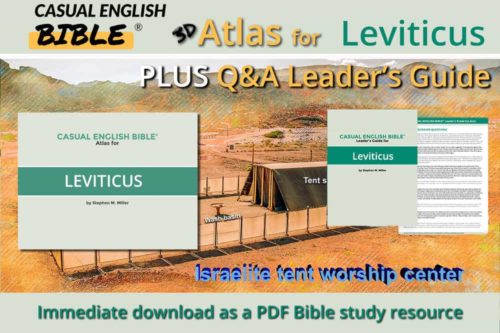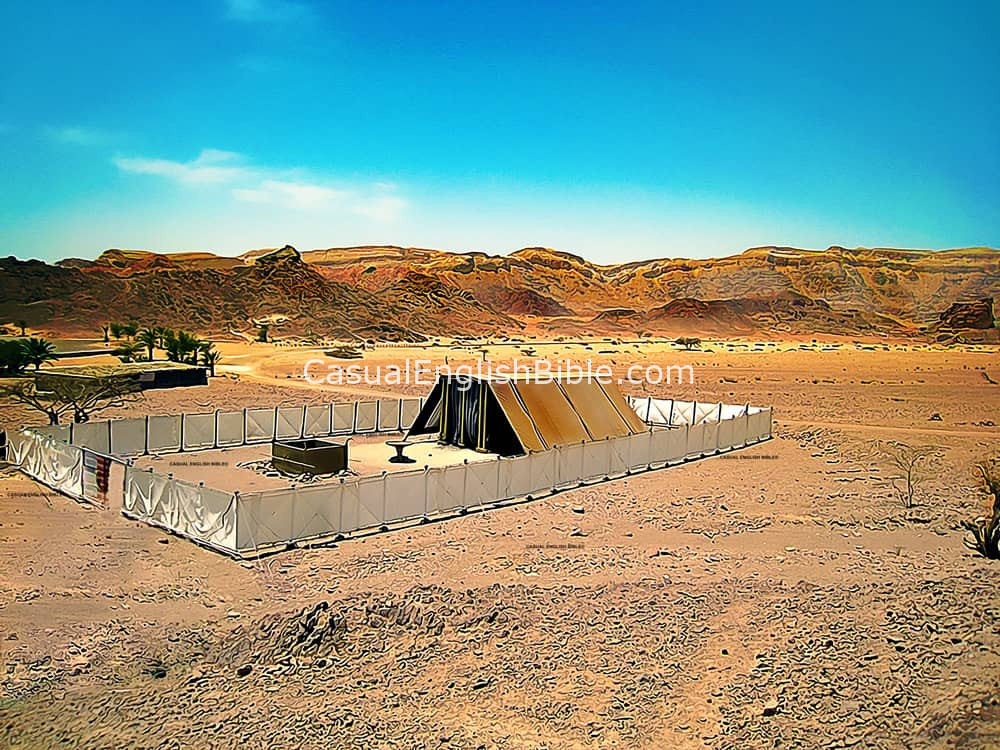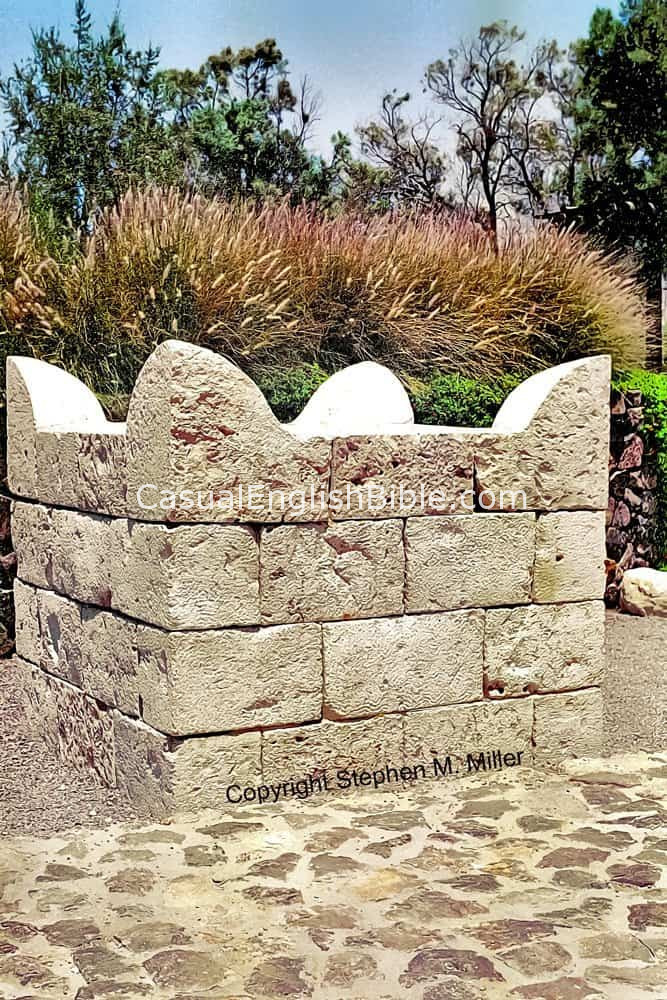Leviticus 9
Aaron’s first sacrifices as priest
What to sacrifice: four offerings
1Eight days [1] after Moses ordained Aaron and his sons for ministry as Israel’s priests, Moses called in a group of older men—leaders in the community.2Moses told Aaron, “Find a young bull, a calf, you can sacrifice for a sin offering [2] and a ram for a burnt offering. [3] Make sure there’s nothing wrong with either animal. Then kill them and offer them to the LORD. 3Then you need to deliver this message to the people of Israel: ‘Find a ram, a male goat, for a sin offering. [4] Then find a couple of one-year-old animals you can sacrifice as burnt offerings: one calf and one lamb. Make sure there’s nothing wrong with either of them.
4Also find a bull and a ram for peace offerings [5] you can bring to the LORD. And bring a grain offering, [6] too. It should be something made of grain or flour mixed with olive oil. Do all of this because today, the LORD is going to come to you.’”
Sacrifices Aaron brought
5Everyone did what Moses said. They brought their sacrificial animals to the tent worship center. They all stood together, waiting for the LORD.6Moses told them, “Here’s what the LORD said you need to do if you want to see him. So pay attention.” 7Moses turned to Aaron and said, “Come over to the altar and give your sin offering to the LORD, along with your burnt offering. This will atone for anything you or the people have done wrong. Then give the LORD the sacrifices the people brought. This, too, will erase their sins, as you do what the LORD said.”
8So Aaron killed the young bull and burned it on the altar as a sin offering for himself. 9Aaron’s sons collected the bull’s blood and gave it to him. Aaron dipped a finger in the blood and painted some of it onto the four horns [7] at the four corners of the altar. He poured the rest around the base of the altar. 10Aaron burned on the altar the animal’s fat, along with the two kidneys and the long lobe of the liver. [11] All of this went up in smoke as an offering, just as the LORD instructed Moses. 11Aaron took the rest of the animal—the beef and the hide—outside the camp. He burned it there.
12Next, Aaron killed the ram for the burnt offering. Again, his sons brought him the blood and he splashed it around all four sides of the altar. 13They cut up the animal into manageable pieces and handed each piece to him. He burned it all on the altar, including the ram’s head. Everything went up in smoke as an offering. 14Then Aaron washed the ram’s internal organs and intestines along with the legs. He burned them on the altar, and they went up in the smoke of the burnt offering.
Sacrifices the people brought
15Then Aaron gave the people’s offerings to the LORD. He killed the goat for the people’s sin offering, just like he had done for his own personal sin offering. 16Aaron then gave their burnt offering to the LORD, following the proper rituals.17Next, he took a handful from the grain offering and burned it to smoke alongside the burnt offering he gave to the LORD every morning. 18Then, he killed the bull and ram for the peace offerings the people brought to the LORD. Again, Aaron’s sons brought him the blood, which he splashed onto all four sides of the altar.
19They collected the animal’s fat, along with the large, fatty tail, [9] both kidneys, and the lobe of liver. 20They piled all of this onto the animal’s breast meat. Aaron burned all but the breast on the altar. It went up in smoke as a peace offering. 21Then he took the breast meat and the animal’s right thigh and waved [10] it as a symbolic offering to the LORD. That’s what Moses had told him to do. 22Aaron then turned to the people, raised his hands, and wished them well in a blessing. After he gave the LORD the sin offering, burnt offering, and peace offerings, he stepped down from the altar.
God’s glory, a flash fire
23Moses and Aaron left the worship center’s courtyard and walked into the sanctuary of the tent worship center, the Sacred Room. [11] When they came out, the LORD’s glory came with them. They spoke hopeful and encouraging words of blessing to the people. 24The LORD’s glory appeared as a fire that leaped from the tent worship center and onto the altar. It quickly consumed the rest of the burnt offering. When the people saw this, they screamed and dropped—face to the ground.Footnotes
The seven-day waiting period for Aaron and his sons was over (Leviticus 8:35). They had now become full-fledged priests.
A sin offering can refer to something the people of Israel brought to God after they realized they had accidentally broken one of God’s laws earlier. Some scholars say a better translation is the opposite of “sin” because the sacrifice is intended to “un-sin” people, to purify them. So those scholars call it a “purification offering.”
This was the most common sacrifice. Worshipers burned the entire animal. Burnt offering instructions: “Take the animal to the north side of the altar. Kill it there on this sacred site of the LORD. Aaron’s sons the priests will take some of the blood and splash it on all four sides of the altar. Cut the animal into pieces, including the head and the fat. A priest will set them onto the fire on the altar” (Leviticus 1:11-12). See also Leviticus 1:3-13; 6:1-6.
This is apparently one animal offered on behalf of all the people, not one animal from every family.
A peace offering, also described in Leviticus 3, is one of several prescribed offerings in Jewish tradition. When Jewish people wanted to thank God for something, such as good health or safety, they would sacrifice a sheep, goat, cow, or bull. They would burn part of the animal, including the kidneys and fat covering the intestines. They would eat the rest in celebration, often with family and friends. It takes a fair number of hungry people to eat a cow. But people were eager to eat meat because it was rare in Bible times for common folks to eat meat, many Bible scholars say.
Grain offerings were expressions of gratitude for a harvest and for the way God takes care of the Israelites. People offered the grain in several ways: ground to fine flour, presented as baked, fried, cooked in a pot, or roasted with olive oil.
Archaeologists have uncovered many “horned altars” in Israel and Palestinian Territories. Bible writers never explained why altars were built with the corners turned up like animal horns. Perhaps the horns were a tribute to the livestock sacrificed on the altar. One more common guess is that the horns gave priests something to which they could tie the dead animal. This could help keep the sacrificed animal from rolling off the fire before it was burned. Psalm 118:27 seems to add credibility to that theory: “Go ahead and tie the festival sacrifice to the four corners of the altar.” Consider how it might feel for a worshiper to watch the sacrificed animal roll off the flaming altar before the animal had even caught fire. We might understand that the animal fell off because the burning wood pile shifted as wood disintegrated in the fire. But someone offering a sacrifice to seek forgiveness for sin might think God had just rejected the offering.
Literally, “finger of the liver.” It’s usually identified as the caudate lobe. There are three other lobes: right, left, and quadrate.
Herders bred fat-tailed sheep in and around what is now Israel and Palestinian Territory. The tail of a mature ram could weigh 20 pounds (9 kg) or more. Fat on the tail was considered the tastiest meat a sheep had to offer.
This sacrificial offering goes by various names: peace offering, fellowship offering, elevation offering, symbolic offering, special offering, and wave offering. The Hebrew word can mean to wave, lift, or blow. In Exodus 29, this sacrifice represented the culmination of an ordination service authorizing priests for ministry. It was the final act, which some scholars say was mainly an expression of gratitude to God for allowing these men to be assigned to lead the worship rituals for the people of Israel.
The Sacred Room was the main sanctuary inside the tent worship center. Aaron’s sons were allowed to go in this room. But the Most Sacred Room was off limits to everyone but Aaron and Moses. That’s where God met with Moses to give him instructions. This holiest place on earth to Israelite ancestors of the Jewish people is where they kept the gold-plated box that held the two stones containing the Ten Commandments. The box is best known as the Ark of the Covenant. A curtain separated this room from the main room in the tent worship center sometimes known as the Tabernacle and sometimes as the Meeting Tent. The Sacred Room was the main sanctuary inside the tent worship center. Aaron’s sons were allowed to go in this room.
Discussion Questions
- 1
BY ROBERT V. HUBER
After remaining secluded in the inner parts of the tent worship center for seven days, Aaron and his sons were finally fully ready to begin their jobs as priests. The first thing Moses did on the eighth day was call in the elders. Why do you think he did that? Was it because young leaders wanted to get their elders’ perspective?
- 2
On the eighth day after the ordination, Aaron begins his job as high priest by offering a number of sacrifices. One of these stands out. As instructed by Moses, Aaron sacrifices a calf as a sin offering. This is the only place in the instructions for making sin offerings that a calf is specified. Do you think there was a special reason that Aaron sacrificed a calf?
- 3
When God appears at the end of this series of sacrifices it is in the form of fire. Why do you think he chose fire? Why not a bright light or wind or thunder?
- 4
LIFE APPLICATION: All the detailed small steps in offering various types of sacrifices may seem tedious to us today and reading about them can be boring. We generally want our worship to feature something bigger and splashier, accompanied by soaring organ chords and full-voiced choirs or the congregations shouting Halleluiah or Amen! We want to ecstatically pour out our hearts to God. Most of the time, though, our religious services are small and relatively quiet, while still being highly satisfying. What are some of the most satisfying small moments you have experienced in worship?








